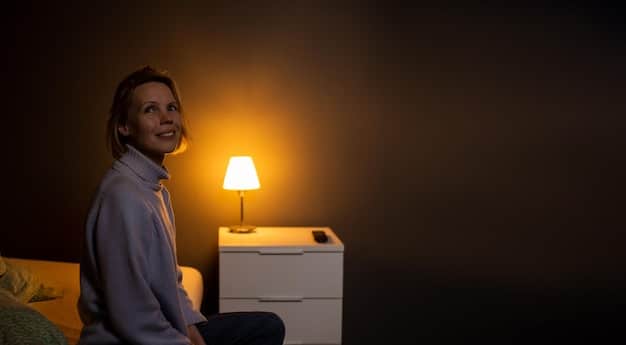Combat SAD This Winter: 5 Strategies for Improved Mental Health

Combat Seasonal Affective Disorder (SAD) This Winter: 5 Proven Strategies for Improved Mental Health by incorporating light therapy, maintaining a consistent sleep schedule, engaging in regular exercise, optimizing your diet, and seeking professional support for improved mental wellness.
As the days shorten and winter settles in, many people experience a significant shift in their mood and energy levels. This is often attributed to Seasonal Affective Disorder (SAD), a type of depression linked to changes in the seasons. But don’t let the winter blues get you down. There are effective strategies you can use to combat Seasonal Affective Disorder (SAD) This Winter: 5 Proven Strategies for Improved Mental Health.
Understanding Seasonal Affective Disorder (SAD)
Seasonal Affective Disorder (SAD) is more than just feeling a little down during the winter months. It’s a recognized form of depression that typically occurs during the fall and winter seasons, when there is less natural sunlight. Understanding what SAD is and how it affects you is the first step in finding effective strategies to manage it.
SAD is believed to be caused by a disruption in the body’s natural circadian rhythm, which regulates sleep, mood, and hormone production. Reduced sunlight exposure can lead to a decrease in serotonin levels, a neurotransmitter associated with feelings of well-being, and an increase in melatonin, a hormone that regulates sleep, potentially leading to lethargy and depression.
Recognizing the Symptoms of SAD
Identifying the symptoms of SAD is crucial for early intervention. Common symptoms include persistent feelings of sadness, loss of interest in activities you once enjoyed, changes in appetite or weight, sleep problems, fatigue, difficulty concentrating, and feelings of hopelessness or worthlessness.
These symptoms can significantly impact daily life, affecting work, relationships, and overall well-being. If you suspect you may have SAD, it’s important to consult with a healthcare professional for an accurate diagnosis and appropriate treatment plan.
Who is at Risk for SAD?
While anyone can develop SAD, certain factors can increase your risk. Women are more likely to experience SAD than men, and it is more prevalent in people who live farther from the equator, where there is less sunlight during the winter months. A family history of depression or other mood disorders can also increase your vulnerability.
- Age: SAD is more common in younger adults.
- Family History: A family history of depression or SAD increases risk.
- Geographic Location: Living far from the equator increases the likelihood.
- Pre-existing Conditions: Individuals with depression or bipolar disorder may be more susceptible.
Understanding these risk factors can help you be more proactive in addressing symptoms as they arise. Early intervention is essential to prevent the condition from worsening and to improve your quality of life during the winter months.
In conclusion, Seasonal Affective Disorder is a significant mental health concern affecting many during winter. Knowing the symptoms and risk factors helps in early recognition and management. Seeking timely help and adopting proactive strategies allows for effective coping and improved well-being.
Light Therapy: A Bright Idea to Combat SAD
One of the most effective and widely recommended treatments for SAD is light therapy. This involves using a special light box that mimics natural sunlight to help regulate your body’s internal clock and improve mood. Light therapy can be a simple yet powerful tool in managing the symptoms of SAD.
Light boxes provide a specific intensity of light that compensates for the lack of natural sunlight during the darker months. By sitting in front of a light box for a certain period each day, you can help restore the balance of neurotransmitters in your brain and alleviate symptoms of depression.

How to Use a Light Box Effectively
To maximize the benefits of light therapy, it’s essential to use a light box correctly. Most experts recommend using a light box that emits 10,000 lux of light and sitting about 16 to 24 inches away from it. The duration of exposure can vary, but typically ranges from 20 to 30 minutes each morning.
It’s also important to position the light box so that the light enters your eyes indirectly. You shouldn’t stare directly at the light, but rather engage in other activities like reading, working, or eating while using the device. Consistency is key, so try to use the light box at the same time each day for optimal results.
- Timing: Use the light box in the morning for best results.
- Distance: Sit about 16 to 24 inches away from the light box.
- Duration: Use for 20 to 30 minutes daily.
- Consistency: Use the light box at the same time each day.
By adhering to these guidelines, you can significantly improve the effectiveness of light therapy and help alleviate the symptoms of SAD. Be sure to consult with a healthcare provider to determine the best approach for your specific needs.
In summary, light therapy is a viable tool for fighting SAD. Proper use, including correct box intensity, time, and consistency, is crucial for optimal outcomes. Seeking advice from health experts guarantees safe, personalized integration into your winter wellness plan.
Maintaining a Consistent Sleep Schedule
A regular sleep schedule is vital for overall health, and it’s especially important when dealing with SAD. Consistent sleep patterns help regulate your body’s circadian rhythm, which can be disrupted during the winter months due to reduced sunlight exposure. Establishing a routine can significantly improve your mood and energy levels.
Going to bed and waking up at the same time each day, even on weekends, can help synchronize your internal clock. This consistency can enhance the production of hormones that regulate mood and sleep, making it easier to fall asleep and wake up feeling refreshed.
Tips for Improving Your Sleep Hygiene
In addition to maintaining a consistent sleep schedule, practicing good sleep hygiene can further improve your sleep quality. This includes creating a relaxing bedtime routine, optimizing your sleep environment, and avoiding stimulants before bed.
A relaxing bedtime routine might involve taking a warm bath, reading a book, or practicing meditation. Your sleep environment should be dark, quiet, and cool. Avoid caffeine and alcohol close to bedtime, and limit screen time, as the blue light emitted from electronic devices can interfere with sleep.
- Create a Routine: Establish a relaxing bedtime routine.
- Optimize Environment: Ensure your bedroom is dark, quiet, and cool.
- Avoid Stimulants: Limit caffeine and alcohol before bed.
- Limit Screen Time: Reduce exposure to blue light from electronic devices.
By incorporating these tips into your daily routine, you can significantly improve your sleep hygiene and promote better sleep quality, which is essential for managing SAD. Remember, good sleep is a cornerstone of mental and physical well-being.
Ultimately, a stable sleep pattern anchors your body’s natural rhythms. Following a consistent schedule and good sleep practices greatly improves your mood and vitality. These steps create a solid base against the impacts of SAD during winter.
The Power of Exercise: Boost Your Mood Naturally
Regular physical activity is a powerful tool for combating the symptoms of SAD. Exercise has been shown to boost mood, reduce stress, and improve overall mental health. Engaging in regular exercise can help elevate your mood and increase energy levels during the winter months.
When you exercise, your body releases endorphins, which are natural mood boosters. Physical activity can also increase levels of serotonin and other neurotransmitters that play a role in regulating mood. Furthermore, exercise can improve sleep quality and reduce feelings of fatigue, both of which are common symptoms of SAD.

Finding the Right Exercise for You
The best type of exercise for combating SAD is one that you enjoy and can stick to consistently. This might include aerobic activities like walking, jogging, swimming, or cycling. Strength training, yoga, and dance are also great options.
Aim for at least 30 minutes of moderate-intensity exercise most days of the week. If you’re new to exercise, start slowly and gradually increase the intensity and duration of your workouts. Even short bursts of activity throughout the day can be beneficial.
- Aerobic Exercise: Walking, jogging, swimming, and cycling.
- Strength Training: Lifting weights or using resistance bands.
- Yoga: Improves flexibility and reduces stress.
- Dance: A fun and engaging way to get exercise.
By finding an exercise routine that you enjoy and incorporating it into your daily life, you can significantly improve your mood and manage the symptoms of SAD. Remember, consistency is key, so choose activities that you find enjoyable and that fit into your lifestyle.
To sum up, consistent exercise is a natural mood lifter, which makes it perfect for fighting SAD. Picking enjoyable activities and keeping with them helps to uplift your spirits. Exercise is an effective, drug-free way to enhance mental wellness during winter.
Optimizing Your Diet: Nourishing Your Mind
What you eat can have a significant impact on your mood and overall mental health. Optimizing your diet to include nutrient-rich foods can help combat the symptoms of SAD. A well-balanced diet supports brain function and helps regulate mood.
Focus on incorporating foods that are rich in vitamins, minerals, and antioxidants. These nutrients help support brain health and can improve mood and energy levels. Additionally, certain foods can help boost serotonin levels, which can be depleted during the winter months due to reduced sunlight exposure.
Foods That Can Help Combat SAD
Certain foods are particularly beneficial for combating the symptoms of SAD. These include foods rich in omega-3 fatty acids, vitamin D, and complex carbohydrates. Omega-3 fatty acids are found in fatty fish like salmon and tuna, as well as in flaxseeds and walnuts. Vitamin D can be obtained from fortified foods, supplements, and limited sun exposure. Complex carbohydrates are found in whole grains, fruits, and vegetables.
Avoid processed foods, sugary drinks, and excessive amounts of caffeine and alcohol, as these can worsen symptoms of depression and anxiety. Additionally, staying hydrated by drinking plenty of water is essential for overall health and can help improve mood and energy levels.
- Omega-3 Fatty Acids: Found in fatty fish, flaxseeds, and walnuts.
- Vitamin D: Obtained from fortified foods and supplements.
- Complex Carbohydrates: Found in whole grains, fruits, and vegetables.
- Hydration: Drink plenty of water throughout the day.
By making conscious dietary choices, you can nourish your mind and help combat the symptoms of SAD. Remember, a well-balanced diet is a cornerstone of overall health and can significantly impact your mood and well-being.
In essence, a balanced diet full of key nutrients is crucial in managing SAD. Prioritizing foods that boost mood and energy and staying hydrated will support mental wellness during winter, making healthy eating an important strategy.
Seeking Professional Support
While self-help strategies can be effective in managing the symptoms of SAD, sometimes professional support is necessary. Talking to a therapist or psychiatrist can provide you with additional tools and strategies for coping with SAD. Professional support is crucial for those who experience severe symptoms.
A therapist can help you identify negative thought patterns and develop coping mechanisms to manage your symptoms. Cognitive-behavioral therapy (CBT) is a common type of therapy used to treat SAD. A psychiatrist can prescribe medications, such as antidepressants, to help regulate mood and alleviate symptoms.
When to Seek Professional Help
If your symptoms of SAD are severe or interfere with your daily life, it’s important to seek professional help. Signs that you may need professional support include persistent feelings of sadness, loss of interest in activities, difficulty concentrating, changes in appetite or weight, sleep problems, and thoughts of self-harm.
Don’t hesitate to reach out to a mental health professional if you’re struggling with SAD. With the right treatment, you can manage your symptoms and improve your quality of life. Remember, seeking help is a sign of strength, not weakness.
- Severe Symptoms: Persistent feelings of sadness or loss of interest.
- Interference with Daily Life: Difficulty concentrating or changes in appetite.
- Thoughts of Self-Harm: Immediate professional intervention is needed.
- Persistent Sleep Problems: Unresolved sleep issues affecting daily life.
By seeking professional support when needed, you can gain access to effective treatments and strategies for managing SAD. Remember, there is no shame in seeking help, and it can make a significant difference in your well-being.
In conclusion, seek professional help when symptoms are severe or affect life. Therapy, such as CBT, and possible medication can improve handling SAD. Seeking help demonstrates strength, offering paths to better mental well-being.
| Key Point | Brief Description |
|---|---|
| 💡 Light Therapy | Use a 10,000 lux light box for 20-30 minutes each morning to mimic natural sunlight. |
| ⏰ Consistent Sleep | Maintain a regular sleep schedule to regulate your body’s circadian rhythm. |
| 💪 Regular Exercise | Engage in physical activity to boost mood and reduce stress. |
| 🍎 Healthy Diet | Optimize your diet with nutrient-rich foods to support brain function and regulate mood. |
Frequently Asked Questions (FAQ)
▼
SAD is a type of depression related to changes in seasons, starting and ending at about the same times every year. It typically occurs in the fall and winter months when there is less natural sunlight.
▼
Light therapy uses a special light box to mimic natural sunlight, helping to regulate your body’s internal clock and improve mood. The light box emits a specific intensity of light that compensates for the lack of natural sunlight.
▼
Consistent sleep patterns regulate your body’s circadian rhythm, which can be disrupted during the winter months. Establishing a routine can improve mood and energy levels, essential for managing SAD.
▼
The best kind of exercise is one that you enjoy and can stick to consistently. This might include aerobic activities like walking, jogging, or swimming. Aim for at least 30 minutes of moderate-intensity exercise most days.
▼
If your symptoms of SAD are severe, interfere with daily life, or include thoughts of self-harm, it’s important to seek help. A therapist can assist, and medication, as prescribed by a psychiatrist, can offer relief.
Conclusion
Combat Seasonal Affective Disorder (SAD) This Winter: 5 Proven Strategies for Improved Mental Health. While winter can present challenges to our mental well-being, understanding the dynamics of SAD and incorporating light therapy, maintaining a consistent sleep schedule, engaging in regular exercise, optimizing your diet, and seeking professional support can help you navigate the season with improved mental and emotional resilience. By taking proactive steps, you can ensure a brighter and healthier winter.





